#luftwaffe bombers
Explore tagged Tumblr posts
Text
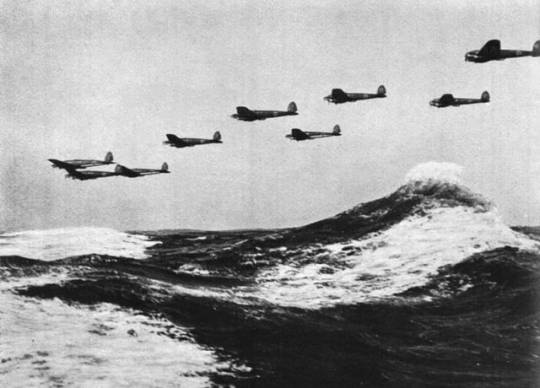
"THE SOUND OF DISTANT AIRCRAFT GROWS LOUDER AND LOUDER...!"
PIC(S) INFO: Spotlight on a reportedly composite photograph of German Heinkel He 111 bombers over the English Channel, flying low in order to avoid all possible British radar frequencies, c. 1940.
[Who caught my 1981 DISCHARGE reference? War is a black hole to avoid!]
Source: www.reddit.com/r/WWIIplanes/comments/111q7fb.
#German Heinkel He 111 bombers#WWII#War photography#Luftwaffe Bombers#German Luftwaffe#Bomber Squadron#Battle of Britain#Luftwaffe#1940s#English Channel#Military history#German Bombers#1940#Bombers#Heinkel He 111 bombers#World War 2#War history#Composite photography#Forties#40s#Battle of Britain 1940#World War II#Heinkel Bombers#Nazi Germany#Photography#Aviation
25 notes
·
View notes
Text

The Horten Ho 229, late WW2 German prototype fighter/bomber. First flying wing powered by a jet engine. First to incorporate stealth technology.
@ron_eisele via X
143 notes
·
View notes
Text

Messerschmitt Me 264 Amerikabomber, location and date unknown. For more, see my Facebook group - Eagles Of The Reich
55 notes
·
View notes
Text
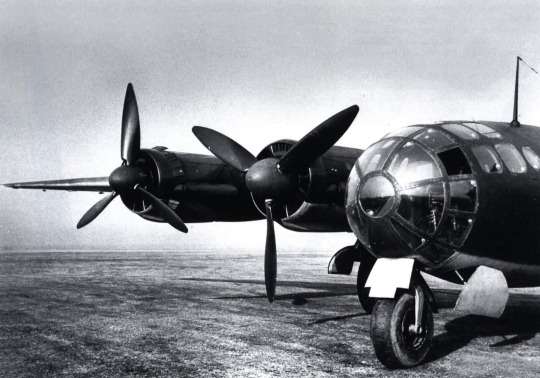
Messerschmitt Me-264 'Amerikabomber'
154 notes
·
View notes
Text
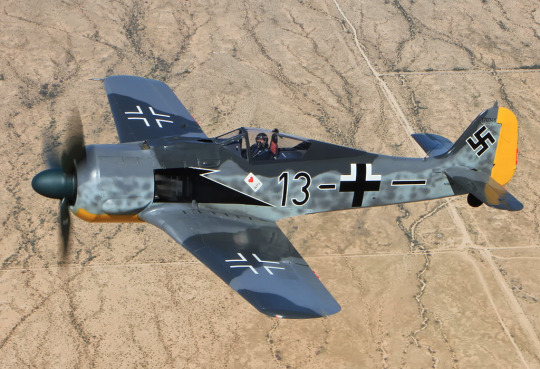
1943 Arado Flugzeugwerke FW-190 A-5 long range night fighter bomber aircraft over Casa Grande, Az
#Flugzeugwerke#FW-190#A-5#JaBo Rei#Night fighter#Fighter Bomber#attack aircraft#Luftwaffe#Vintage aircraft#Würger#warbird#airplane#aircraft#plane
133 notes
·
View notes
Text
"Alice From Dallas" - Going Down

When continuing to investigate what happened exactly to the B-17F "Alice From Dallas" and its crew during this fateful day on August 17, 1943, I found out what is certainly the most detailed account of what happened this day.
Mr. Dirk Thielens from the Belgian association Task Force Liberty (https://www.taskforceliberty.be/) has written an exceptional account of all the events, especially unfoldind from the moment the aircraft was hit at 10.30 a.m by Flak to the aftermath of the crew landing in occupied territory.
You can find the original text written by Dirk Thielens here : https://www.taskforceliberty.be/wp-content/uploads/2018/08/Alice-from-Dallas-deel-1.pdf I thank him very much for having accepted to publish the story he wrote on my blog.
I translated a part of it to English for sharing this incredible story :
"When they had reached the province of Limburg at 10:30 they were fired upon by German anti-aircraft (flak). A heavy shock wave was felt in the aircraft when they were hit by anti-aircraft shells. Immediately the right wing of the aircraft, which was full of fuel, caught fire.
Roy Claytor, the pilot, pushed the nose of the aircraft down to leave the formation. Alice from Dallas began to lose altitude rapidly and threatened to go into a left spin. At that moment Roy noticed that the left wing was also on fire and as a reflex he engaged the autopilot and shouted "bail out!" over the intercom. This was the order for the crew to buckle up their parachutes and bail out. Bombardier Kenneth Lorch did what he had to do in that situation. He opened the bomb hatch and dropped all the bombs, which were still on safe, at once after which he, navigator Oscar Amison and Engineer/top turret gunner John Burgin bailed out of the burning aircraft. While the pilot was still trying to to keep it somewhat under control, co-pilot Raymond Nutting also left the cockpit. Pilot Roy Claytor was meanwhile also standing between the two seats in the cockpit and holding the control column. Suddenly the nose of the aircraft went up and he was sucked into the space behind the cockpit. Roy managed to reach the escape hatch and open it, after which he could jump out of the burning crashing aircraft. He waited to open his parachute to get enough distance to the aircraft, in case it would explode in the air.
Roy saw seven parachutes hanging around him. So two parachutes were missing. These were Edward Musante and William Hinton. Apparently they had not gotten out of the aircraft in time. Musante had managed to jump, but his parachute got caught in the tail of the crashing aircraft and he was dragged down into the depths, to a certain death. Two Focke-Wulf 190s of the Luftwaffe circled the crashing aircraft but they did not open fire. They were probably just looking to see where the plane and the parachutes would land and then alert the German ground troops of the exact location. Roy Claytor opened his parachute at about 1,000 feet (+/- 300 meters) altitude.
He saw the remains of Alice from Dallas come down with a huge explosion a little further away. While hanging from his parachute he was thrown in all directions and landed with a thud in a meadow. For about a minute he was dazed and could not move. About thirty paces further on a dirt road one of his comrades also landed with a thud. Roy Claytor had to shout at him three or four times before he reacted. It was Raymond Nutting, the co-pilot. Raymond had only missed the softer grass field he was aiming for by a few meters because he did not dare to pull the ropes of his parachute at low altitude. They had barely managed to get up and had deployed their parachutes when they were surrounded by a few dozen Belgian civilians from the nearby village. (Probably Schoonbeek).
John Burgin had also jumped from the plane together with bombardier Kenneth Lorch via the forward escape hatch. They had first had to remove some escape equipment and blankets. They jumped from the plane at approximately 12,000 feet (+/- 4,000 meters) and opened their parachutes at an altitude of approximately 2,000 meters. John Burgin took off his flight helmet, goggles and oxygen mask and put them in his overalls. The B-17 circled dangerously in flames in its death throes. For a moment John thought the plane would come their way and drag him down. Fortunately it turned around just in time and left the two crew members unharmed. No detailed account of the facts is available from Kenneth Lorch, but from John Burgin there is. As he was hanging from his parachute and drifting quietly southwards, he saw the Germans busy on the ground. He saw Germans taking up positions on various roads. He was hanging above a forest and when he landed at the edge of the forest, a Belgian civilian was quickly standing next to him. He wasted no time with many words and immediately began to pull the parachute out of the branches of the trees. John quickly took off his flying gear. The parachute and the gear were thrown into old shell craters (probably from the fighting in May 1940) and filled with branches, grass and leaves to camouflage them. They heard a German truck approaching, the Belgian man walked up the forest road to see where the danger was coming from and then signaled to John to quickly walk in the other direction. Waist gunner Charles Bailey also did not hesitate to jump out of the plane when the order came. He always wore his parachute harness loose enough so that he could put his hands in his pockets during the flight. The waist gunner stands to the side of the plane in an opening behind his machine gun.
Flying at that altitude with an open door is a guarantee for freezing temperatures. When Charles opened his parachute, he was hit hard by the rather loose harness. So hard that he thought he was going to be torn to pieces. He pulled off his oxygen mask and dropped it. For a moment he thought he was going to land in a pond, but luckily he drifted off. As he descended, he realized that he should have paid more attention in the courses on what to do when landing behind enemy lines. Luckily, he remembered that you should try to hide your parachute as quickly as possible. Charles landed in a garden and his parachute got stuck in a pear tree. The landing itself was pleasant and easy. At least 50 people gathered around him in a circle.
They asked him if he was English or German. When he made it clear that he was American, they spontaneously started hugging and kissing him. He had not yet had breakfast and was spontaneously offered pears from the tree. After his parachute was lowered, he took off his leather jacket and his coverall. There was a piece of shrapnel in his leg and he tried to treat it with a piece of his parachute. While he was administering first aid to himself, the people made it clear to him that he had to get out of there and hide. The people took his equipment and he hid in a ditch. There they brought him food and civilian clothes. The people hung around in the area and strangely enough no Germans showed up. About an hour later they brought him a bicycle and from there his journey was organized.
Of the ten crew, eight managed to escape by parachute. Two crew members, Edward Musante and William Hinton, were killed. Charles Bailey later recalled: “Musante was the right side gunner and I was the left side gunner. I kept a close eye on him at all times because I was older than he was and he seemed to depend on me a great deal. He always had trouble understanding what was said on the intercom and I always made sure he knew what was being said. Also when the pilot gave the signal to jump I checked Musante and he got ready. We both went to the escape hatch and I pulled the lever and Musante went forward to jump. But suddenly he changed his mind and signaled me to go first. Two engines were on fire and the plane was descending very rapidly so I saw no reason to lose any time and jumped. After my parachute opened I tried to keep my eyes on the plane and count the parachutes but I could only see eight.” So what actually happened to Musante is not really clear.
Did he hesitate to jump at the last moment and thereby seal his fate? It is certain that he got caught in the tail with his parachute. Also William Hinton the ball turret gunner could not leave the plane in time. His body was found after the crash among the wreckage. Both crew members were temporarily buried in Genk on 20 August 1943 and were reburied in their home country after the war."
#flying fortress#b 17 flying fortress#masters of the air#8th air force#b-17#b17#usaaf#wwii#wwii germany#genk#belgium#flak#Schweinfurt#Regensburg#bombing campaign#bomber#USAAF#luftwaffe#b17 project#b17 stories
11 notes
·
View notes
Text

Mitrailleur de nez d'un bombardier moyen Heinkel He 111 avec une mitrailleuse MG 15 – 1940's
#WWII#luftwaffe#aviation militaire#military aviation#bombardier#bomber#bombardier moyen#medium bomber#heinkel he 111#he 111#1940's
65 notes
·
View notes
Video
youtube
WW2 Amerikabombers. The Secret Aircraft That Aimed To Bomb The U.S. PART 2
#youtube#amerikabomber#americabomber#luftwaffe#heinkel#Messerschmitt#dronescapes#aviation#ww2#wwii#ww2 history#ww2 germany#ww2 aircraft#wwii era#wwii history#bomber#documentary
10 notes
·
View notes
Text


Junkers JU-87 Stuka dive bomber
24 notes
·
View notes
Text
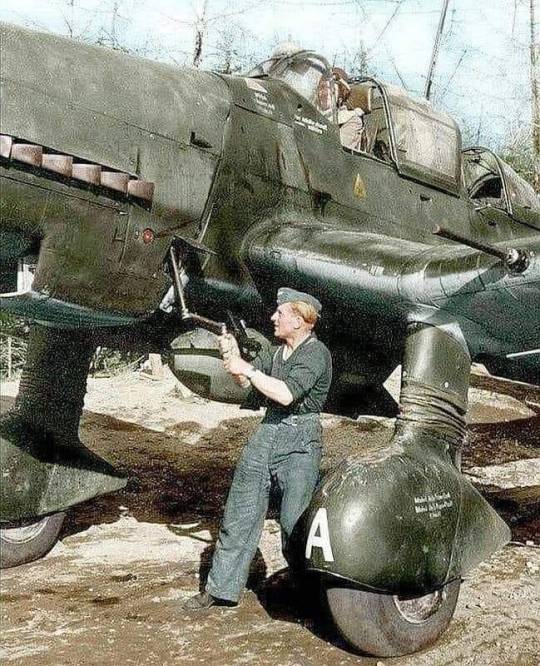
Start einer Ju-87 Stukka
41 notes
·
View notes
Text
I want to go inside a He 111 is that too much to ask
#rhetorical question because yeah it's too much to ask and I haven't even seen one in person. I want to look out the asymmetrical nose :[#I'd also except a CASA 2.111 honestly#it's one of my favorite planes in general it looks neat and it's interesting how Germany tried to disguise it as a passenger plane#like imagine a war starts and the Luftwaffe goes ''Oh heyyy this plane is conveniently perfect as a bomber wow what a coincidence 👀''#heinkel he 111#he 111#aviation
3 notes
·
View notes
Text

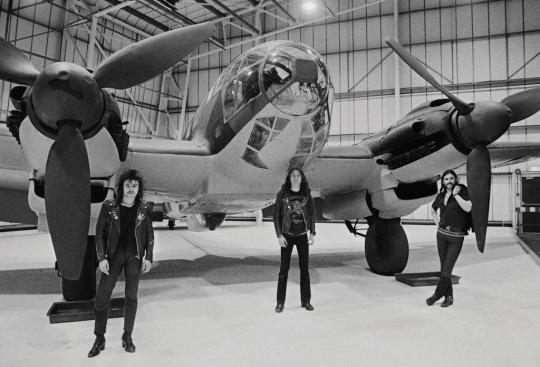


READY FOR TAKE-OFF -- INTO THE ROCK & ROLL STRATOSPHERE AND BEYOND.
PIC(S) INFO: Spotlight on English rock and roll/metal punk group MOTÖRHEAD posing next to a Heinkel He 111 bomber at the Imperial War Museum in London, c. 1979. 📸: Chalkie Davies.
In memoriam -- Phil "Philthy Animal" Taylor, "Fast" Eddie Clarke, Lemmy Kilmister, and may God rest all their souls forever. HAIL!!
Source: www.pressreader.com/uk/classic-rock/20190528/283059825843608.
#MOTÖRHEAD#MOTÖRHEAD 1979#1979#Rock and Roll#Imperial War Museum#London UK#Power Trio#Metal punk#Rock 'n' roll#Bomber#Bomber 1979#Heinkel He 111#World War II#German Luftwaffe#World War 2#70s#Lemmy Kilmister#Philthy Animal Taylor#Aviation#Fast Eddie Clarke#Luftwaffe#Aircraft#Guitarist#Drummer#1970s#London England#Motörmusic#WWII#Heinkel He 111 bomber#Punk metal
7 notes
·
View notes
Text

Spectacular photo of a Stuka in a dive taken during the Battle of Britain.
The Stuka had an automatic dive control, which was set by the pilot to the desired recovery altitude via a contact altimeter.
The pilot opened the intradoxal dive brakes, which immediately put the plane in a dive, and manually adjusted the angle by aligning the red lines at 60°, 75° or 80° on the side window of the cockpit with the horizon. The pilot then aimed at the target with the sight of the machine gun as in a fighter, using the rudders to obtain the correct alignment with the target. When the altimeter warning light was turned on, the pilot pressed a button on the joystick for automatic recovery, normally at an altitude of 450 m above the ground. If this did not occur, the pilot had to pull back the lever with all his strength, helped by the careful use of the depth rudder compensator.
@alafissaerotante via tumblr
#stuka#junkers#dive bomber#luftwaffe#ww2#ww2 aircraft#ww2 aviation#aviation#aircraft#military aircraft#aviation military#military aviation#aviation military pics
70 notes
·
View notes
Text

A Staffel (squadron) of Junkers Ju 87B Stukas from 7./StG 77, Battle of Britain, 1940. For more, see my Facebook group - Eagles Of The Reich
72 notes
·
View notes
Text
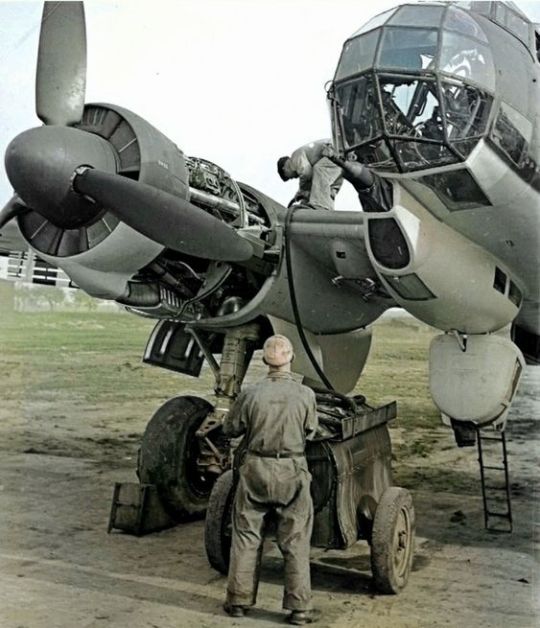
Ground crew refuel Junkers Ju-88
128 notes
·
View notes
Text
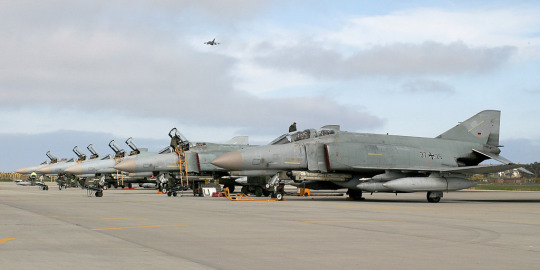
German Phantoms at RAF Lossiemouth - 2007
#German Air Force#Luftwaffe#McDonnell Douglas#F-4#Phantom#Phantom II#Military#aviation#Bundeswehr#Fighter#Fighter Bomber#Interceptor#jet#airplane#combat aircraft
48 notes
·
View notes